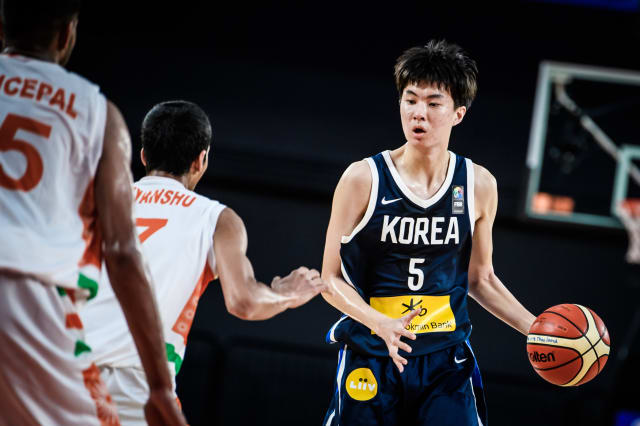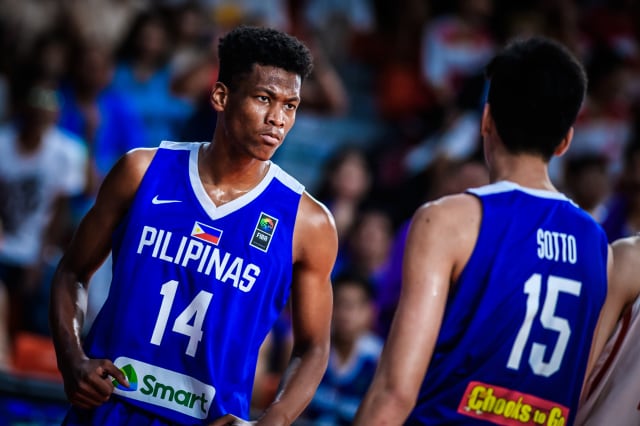This is how the best FIBA U18 Asian Championship scorers are scoring
NONTHABURI (FIBA U18 Asian Championship 2018) – There are plenty of promising scorers on display here in Thailand at the FIBA U18 Asian Championship. Let’s break it down how they've done it!
NONTHABURI (FIBA U18 Asian Championship 2018) – There are plenty of promising scorers on display here in Thailand at the FIBA U18 Asian Championship. What makes it even more fun is that they are all doing their damage with a lot of variety. Let’s break it down how some of the best have been putting points on the board in the first three days of competition!
Rajeev Kumar (IND)

After putting up a modest 12 points in his debut match, Kumar exploded for consecutive games of 40 and 32 points against Korea and Syria, respectively. The tournament’s current leading scorer (28.0) gets a majority of his points from three-pointers, where he leads the tournament in both attempts (12.3 per game) and makes (4.3 per game). Coach Aman Sharma has clearly given him the green-light to fire and open up the floor which he’s doing so at a decent rate.

Kumar is not only a shooter and likes to take advantage of teams getting used to his sniping tendencies by blowing by defenders that close in on him. He’s a capable strong finisher who is just as deadly scoring inside as he is from beyond the arc.
Hyunjung Lee (KOR)

Lee is the only player in the tournament so far to put up at least 20 points in every game and he’s doing it at a ridiculously efficient rate. His 26.7 points per game come from 50.9 FG%, 46.2 3P%, and 73.7 FT%. It comes to no surprise that he leads the tournament in efficiency at 31.7, the only player to average more than 23.

The impressive thing about how Lee puts his points on the board is that he takes what the defense is giving him. India struggled to rotate quickly enough on the perimeter and Lee let loose from downtown, knocking down 6 of 12 attempts. Against Chinese-Taipei who pressured further out of the zone, Lee attacked the basket and got 9 points off 13 free-throw attempts. Syria couldn’t keep up with Korea’s speed so Lee just blitzed up ahead and constantly scored in transition.
Samson Froling (AUS)

Australia has a well-balanced offense that doesn’t rely much on any particular player so far in the FIBA U18 Asian Championship, but it’s still worth breaking down how their leading scorer get his points.

While Froling (16.3 PPG) does most of his work down low, he’s not a typical post it up and bang it down low big guy. He uses swift movements to get open and quickly convert accurate passes from his teammates into points. There probably won’t be many opportunities for Froling to take threes like he did against Thailand, but it’s nice know that he can knock them down if he has the chance as well.
Wang Quanze (CHN)

China’s main big man has added more dimension to their offense and is a nice compliment to Guo Haowen’s aggressive attacks from the wing.

Quanze’s debut against UAE displayed his array of post moves and nimble footwork, but also started showing glimpse of how well he was able to do attacking off the dribble. As China pushed the pace, Quanze (18.7 PPG) also did well as the secondary break. In the later games against Lebanon and the Philippines, Quanze showed that he could also start his offense further away from the basket which created more threats in the half-court set. China clearly struggled with Quanze in foul trouble against the Philippines and a part of that was how much he could shift the look of their offense just by being on the court.
AJ Edu (PHI)

The Philippines leading scorer (15.3 PPG) hasn’t been scoring in bunches and has yet to have 20-point game but he doesn’t need to. Most of Edu’s impact comes on the defensive end by rejecting and altering the opponent’s shot attempts, but he also plays a big part in the Philippines offense as well.

Edu can easily use his length to score on offensive putbacks and he can also step out to stretch the floor a bit when he’s paired with Kai Sotto. Don’t expect him to start making it rain, but if the ball rotation is just right, Edu can knock down the occasional long ball as well. In the Philippines big game against China, Edu showed another aspect in his offensive game as he paired up with Sotto for a deadly high-low combination where Edu spots up and knocks down some long jumpers.
Keisei Tominaga (JPN)

By now, everyone knows that Keisei Tominaga is a shooter and a very good one as well. So far, he’s shown that nothing has changed and that he can be one of the most entertaining players to watch when he catches fire.

To no one's surprise, Tominaga scores a lot of his 16.7 points per game from downtown. In fact, he only attempts two-point field goals at half of the rate that he attempts three-pointers. When you are shooting 45.8% from deep, that is pretty much expected. Tominaga also has a nifty floater and soft touch to keep his defenders on their feet, too. And if defenders should foul him and send him to the line, Tominaga his yet to miss a single free-throw attempt in this tournament.
Yan Ting Lin (TPE)

Among one of the smaller players one this list, it’s surprising that Chinese-Taipei’s leading scorer (17.7 PPG) doesn’t rely too much on three-point shooting for his points.

Lin can knock down the three ball, but prefers attacking the basket instead. The 6’0 shooting guard uses his very exceptional jumping ability and speed to get to the rim resulting in a crafty finish or a drawn foul. He leads his team in two-point field goal attempts (10.7) and free-throw attempts (5.0) and that’s with bruising bigs Jonah Morrison and Fan Po-Yen Chen on the team as well.
FIBA